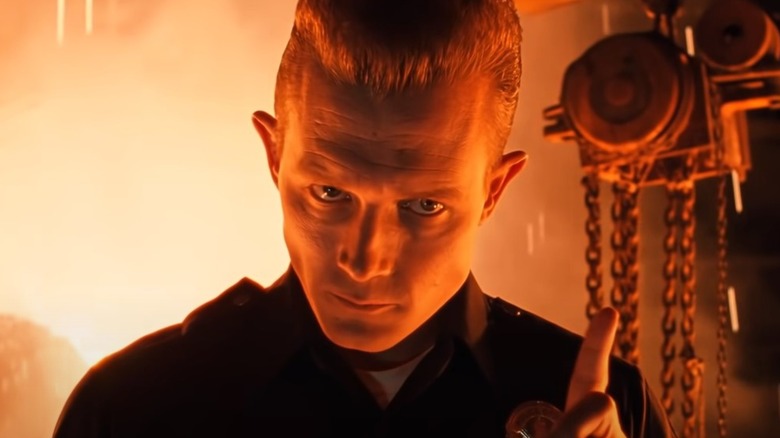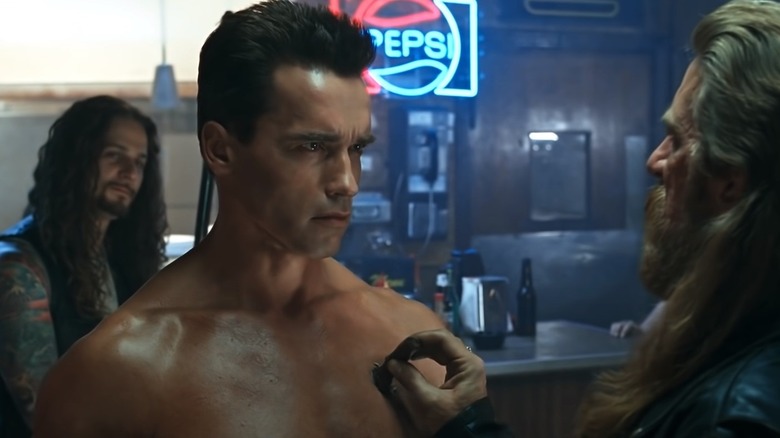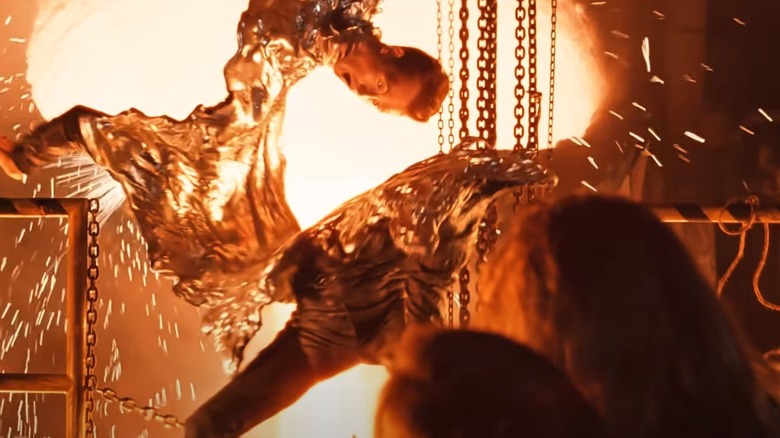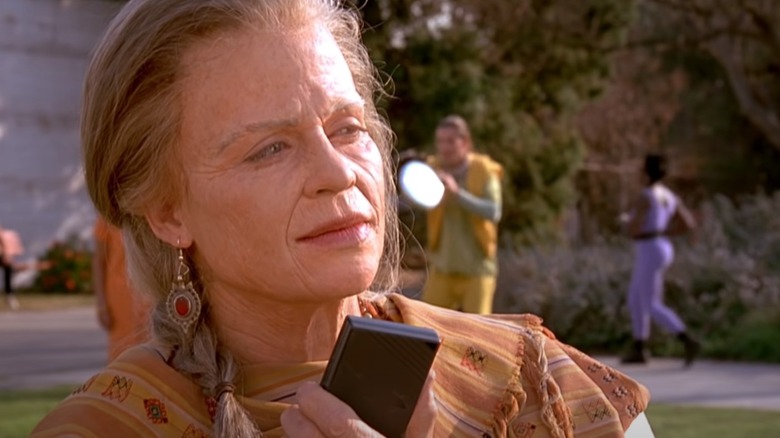The Ending Of Terminator 2: Judgment Day Explained
A sci-fi franchise that closes the door behind itself is a hard thing to find, but that's exactly what fans got with "Terminator 2: Judgement Day," the film that not only put a bow on the Terminator mythos, but represented the concrete end to the series. It was so good, nobody even considered making any more Terminator movies. "No need to get greedy," Hollywood seemed to emote as one, throwing back their hands as if to say, "I couldn't possibly take another bite of this scrumptious, rich, internationally recognizable intellectual property."
In the years between 1984's "The Terminator" and 1991's "T2," future messiah John Connor (Edward Furlong) has developed from a fetus into a nine, 10, or 13-year-old, depending on which bend in the series' maze of continuity you prefer. His mom, Sarah Connor (Linda Hamilton), has started doing a lot of pull-ups, and she's also bombing tech companies. The judicial system takes a dim view of half of these pastimes and politely requests that she stay institutionalized, owing to her bubble-off-plumb belief that an artificial intelligence is going to blow up the world in the far-off future of 1997.
With the pieces in place, all that's left for the movie to do is drop a naked Austrian into a truck stop parking lot. It doesn't disappoint.
Terminator 2 is all Schwarz, no shorts
Out come the time travel shenanigans that the "Terminator" movies can't stop giving us. In one corner, you have Robert Patrick's T-1000, a highly advanced nanorobotic cluster of death and shape-shiftery. Skynet, the machine consciousness that Sarah Connor just won't stop gabbing about, has sent the T-1000 back to end John Connor before he can become the military leader that the future anti-robot resistance so admires. If you've ever watched a football team give up and run nothing but Hail Mary passes for the entire fourth quarter of a game, you'll understand how frustrating it is for Skynet fans to see this play being utilized again.
In the other corner, there's a T-800 — a less advanced, more meat-and-potatoes Terminator, obtained and reprogrammed by John's resistance in the future. The T-800 is sent back to the past to protect young John from the T-1000 in sort of a cybernetic, hyper-violent, time travel-based reimagining of "There Was an Old Lady Who Swallowed a Fly."
Young John and his new pet murderbot form an unlikely friendship and yoink Sarah out of government custody, despite her not being a huge fan of John's new social circle. After some back and forth, the trio sets out with two goals in mind: Don't get killed by the shape-changing robot, and kill Miles Dyson, the guy whose inventions directly lead to the creation of Terminators, theoretically taking the apocalypse off the table for now.
The motherboard said there'd be days like this
No end of hardship later, John, Sarah, and the T-800 convince Dyson to destroy his research, and the inventor goes out in a heroic blaze of glory, detonating any trace of Terminator-adjacent technology in the process.
That still leaves the matter of the T-1000, which tracks the trio to a steel mill and gets started on one of the most cinematic climactic fight sequences in modern movie history. Through the combined powers of friendship, grenade launchers, and 2750-degree molten metal, they end the soulless villain once and for all, eliminating the potential for grabby scientists to get their mitts on futuristic robot technology and kickstart armageddon.
But wait, there's one more machine: the T-800, John's new best friend and Sarah's onramp to a more forgiving lifestyle. Reckoning that the future isn't safe while the tech in his head still exists, the T-800 lowers himself into liquid metal, giving the Thumbs Up That Made a Thousand Grown Men Cry on his way to entropy. Sarah and John drive off into a brighter tomorrow, with Sarah describing a newfound optimism for what's to come. What could happen next?
That's the thing. We don't know. Making another Terminator movie literally never crossed anyone's mind after this.
Just kidding, Terminator 2 never ends
Okay, fine: In theory, "Terminator 2: Judgement Day" ends the Connor/Skynet saga once and for all. Check out the extended edition if you haven't already — it's not just a markedly more excellent movie than the already terrific theatrical cut, but it also offers an alternate ending where Ol' Lady Sarah Connor watches Adult Fella John Connor play with his kid on a playground in a markedly un-scorched future. It's quiet, cathartic, and A-OK.
But what's satisfying to audiences is nails on a chalkboard to studio executives, and new Terminator timelines started popping up like weeds around the turn of the century in a frantic attempt to revitalize the franchise. 2003's "Terminator 3" presented a world where Sarah Connor died not long after "T2" and Judgement Day happened anyway, just a little later than expected. FOX's "The Sarah Connor Chronicles" series ignored "Terminator 3" and sent Sarah and John from 1997 to 2007 as robo-pursued chrono-fugitives. 2009's "Terminator Salvation" disregarded "The Sarah Connor Chronicles," taking viewers to a post-Judgement Day future where the machines were on their way to winning the war and Edward Furlong grew up to look like Christian Bale. "Terminator Genisys" ignored the built-in spell check on its word processor and reworked the whole Terminator story from day one as more of a YA series. "Terminator: Dark Fate" retconned everything after "Terminator 2" and, in turn, audiences ignored "Terminator: Dark Fate."
Like some of its most memorable heroes, "The Terminator" and "T2" are now remembered as grim messengers, sent with a largely disregarded warning to future generations. Their message: "If you fell in love with a franchise from the '80s, maybe don't get too excited about the prequels, sequels, and reboots that follow."



